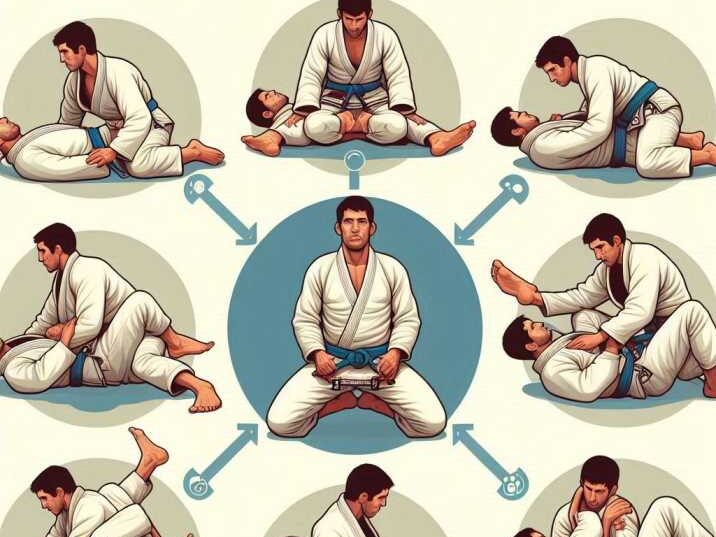Introduction
Table of Contents
Jiu Jitsu is a martial art that focuses on grappling and ground fighting. It helps improve strength, flexibility, and mental focus. Whether you’re looking to learn self-defense or get in great shape, Jiu Jitsu is a fantastic way to train both your body and mind.
This guide will help beginners understand how to do Jiu Jitsu step by step. You’ll learn essential techniques, training tips, and how to progress in your journey.

1. Understanding the Basics of Jiu Jitsu
Jiu Jitsu is all about using technique and leverage to control and submit an opponent. Unlike other martial arts, it does not rely on punches or kicks but focuses on grappling and submissions.
What You’ll Need to Start
- A Gi or No-Gi outfit – Depending on the training style, students wear a Gi (a thick kimono-like uniform) or No-Gi (shorts and a rash guard). Gi training emphasizes grips, while No-Gi focuses more on speed and agility.
- A good training academy – Finding a reputable gym with experienced instructors ensures proper guidance and progression in Jiu Jitsu.
- Patience and discipline – Learning Jiu Jitsu requires consistent effort, discipline, and an open mind to embrace failures and learn from them.
2. Learning Basic Jiu Jitsu Positions
Before practicing submissions, you need to understand different positions.
Guard
The guard is a defensive position where you control your opponent with your legs while lying on your back. There are different types, such as closed guard, open guard, and half guard, each offering various attack and defense options.
Mount
The mount is a dominant position where you sit on your opponent’s torso. This position gives you a solid base to attack with submissions or maintain control in a fight.
Side Control
In side control, you pin your opponent to the ground with your body weight. This position allows you to transition to dominant positions or attempt submissions.
Back Control
One of the strongest positions in Jiu Jitsu, back control involves holding your opponent from behind while securing a strong grip. From this position, you can attempt submissions like the rear-naked choke.
3. Mastering Essential Jiu Jitsu Techniques
Here are some fundamental techniques every beginner should learn:
1. Shrimping (Hip Escape)
Shrimping is a movement that helps create space between you and your opponent. It is crucial for escaping bad positions like mount or side control. The movement mimics a shrimp’s motion, using your hips to push away and reposition yourself.
2. Bridging
Bridging is a powerful motion used to generate force and escape from bottom positions. By pushing off the ground with your feet and arching your hips, you can unbalance your opponent and set up an escape.
3. Armbar
An armbar is a submission that targets the elbow joint. By controlling the opponent’s arm and extending it while applying pressure, you force them to submit or risk injury.
4. Triangle Choke
The triangle choke is a submission that uses the legs to trap an opponent’s neck and arm, restricting blood flow and forcing a tap-out.
4. Practicing Drills for Jiu Jitsu Improvement
Solo Drills
Practicing solo drills helps improve movement, flexibility, and conditioning. Some essential drills include:
- Shrimping – Helps with hip movement and escapes.
- Bridging – Strengthens core muscles and improves escape ability.
- Technical stand-ups – Teaches how to get up safely while protecting yourself.
- Rolls – Improves agility and body awareness.
Partner Drills
Training with a partner enhances timing and technique. Key partner drills include:
- Guard passing – Practicing how to move past an opponent’s legs to gain control.
- Submission defense – Learning how to escape from locks and chokes.
- Positional control – Improving ability to maintain and transition between dominant positions.
5. Training Smart and Avoiding Injuries
Warm-Up Properly
A proper warm-up includes stretching and light cardio exercises to prepare the body for training. Dynamic movements like hip circles, jumping jacks, and rolling drills help prevent injuries.
Tap Out Early
In Jiu Jitsu, tapping out signals submission to avoid injury. It’s essential to tap early rather than resisting a submission, which could result in sprains or fractures.
Listen to Your Instructor
Coaches provide valuable insights into techniques and safety. Paying attention to their advice and practicing under supervision accelerates improvement and prevents bad habits.
6. Advancing in Jiu Jitsu – Belt System
Jiu Jitsu has a ranking system to measure progress.
| Belt Color | Level |
| White | Beginner |
| Blue | Intermediate |
| Purple | Advanced |
| Brown | Expert |
| Black | Master |
7. Benefits of Jiu Jitsu
Improves Focus
Jiu Jitsu training sharpens concentration and mental discipline. Each session requires problem-solving, quick decision-making, and focus to execute techniques correctly, which translates to better focus in daily life.
Boosts Fitness
Jiu Jitsu is a full-body workout that enhances strength, endurance, and flexibility. Rolling, drilling, and conditioning exercises improve cardiovascular health, making it an effective way to stay fit.
Teaches Self-Defense
By learning control, leverage, and submissions, Jiu Jitsu provides effective self-defense techniques. It helps smaller individuals neutralize larger opponents by using technique rather than strength.
Reduces Stress
The physical activity and problem-solving nature of Jiu Jitsu help reduce stress and improve mental well-being. Training provides an outlet for releasing tension, leading to a more relaxed and focused mind.
Table of Information
| Feature | Details |
|---|---|
| Martial Art Type | Grappling, Ground Fighting |
| Origin | Brazil, 1900s |
| Main Focus | Submissions, Positioning, Leverage |
| Training Equipment | Gi (uniform), No-Gi attire, Mats |
| Best For | Self-defense, Fitness, Competition |
| Difficulty Level | Beginner to Advanced |
| Popular Techniques | Guard, Mount, Armbar, Triangle Choke |
Conclusion
Jiu Jitsu is an exciting and rewarding martial art that anyone can learn. By understanding the basics, practicing key techniques, and staying consistent, you can master how to do Jiu Jitsu over time. Jiu Jitsu provides numerous benefits for self-defense, fitness, or competition. Start your journey today and enjoy the path to becoming a skilled practitioner!
FAQs
1. How long does it take to get good at Jiu Jitsu?
Most beginners see progress in a few months, but mastery takes years.
2. Can I do Jiu Jitsu without a partner?
Yes, solo drills help improve movement and flexibility.
3. Is Jiu Jitsu good for self-defense?
Absolutely! It teaches techniques to control and subdue opponents.
4. Do I need to be strong to do Jiu Jitsu?
No, technique and leverage are more important than strength.
5. How often should I train?
Training 2-3 times a week is a great start for beginners.


